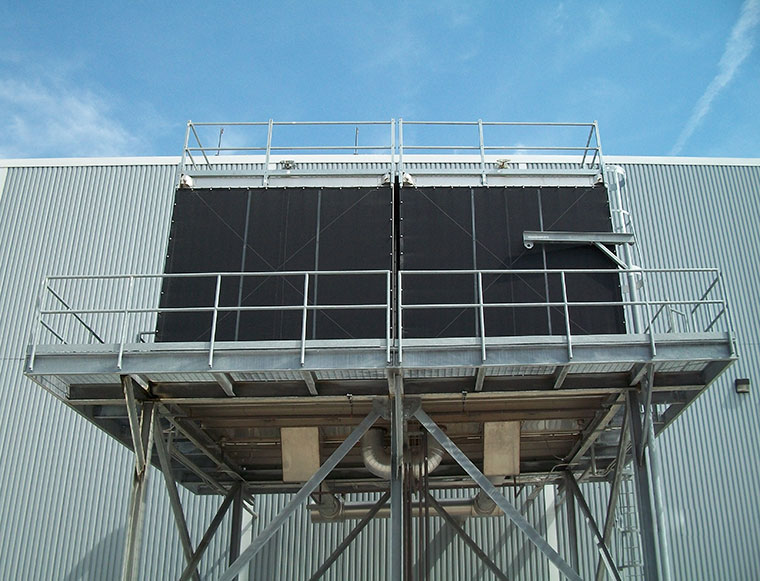
Unfortunately, outbreaks of Legionnaires’ Disease are all too commonplace and on occasion, a cooling tower is responsible for an outbreak. Understanding why cooling towers provide the perfect environment for Legionella cooling tower bacteria to thrive to harmful levels is all-important when it comes to preventing it from happening.
What is a Cooling Tower?
A cooling tower’s role is to remove heat from the water. The waste heat that buildings or production processes produce gets extracted using a local cooling system. Once the heat is cooled by a tower, it is transported and then ejected into the environment. Cooling tower bacteria can be emitted if correct maintenance and water treatments are not routinely carried out.
The actual cooling process is done by mixing heated water and air which lowers the temperature of the water. A good description of the process is to think of a large fan located inside a tower that works overtime to cool heated water causing it to evaporate in the process.
Businesses that Use Cooling Towers
Cooling towers can be found in many locations and are used by many businesses which include:
- Hotels
- Hospitals
- Power plants
- Factories
- Large businesses
- Offices
- Theme parks
Studies estimate that bacteria can be found in at least 60% of cooling towers with some estimates being even higher.
The Perfect Environment for Legionella Bacteria to Thrive
Legionnaires’ disease is caused by an organism called Legionella bacteria which can cause a potentially fatal lung health issue. Water that is the perfect temperature (between 20 and 45 degrees Celsius) is all that the bacteria require to thrive. Any temperature below or above this will not see the bacteria grow and multiply.
Cooling towers operate at different temperatures and as such, there is a risk of the Legionella bacteria forming if nothing is done to prevent it from taking hold. Water is emitted into the air by cooling towers in the form of either evaporated water vapour or unfavourable water droplets (drift). The latter may potentially lead to a scenario where tiny droplets of water are contaminated. The wind can carry the cooling tower bacteria far and wide.
How Legionnaires’ Disease is Contracted
Legionnaires’ disease can be potentially fatal. You contract the disease by inhaling the bacteria into your lungs. This can cause varying degrees of damage to the lungs which includes a relatively milder case of Pontiac fever to the potentially fatal Legionnaires’ disease.
Contaminated droplets of water emitted from a cooling tower can put all nearby at risk of contracting the disease. People in the vicinity are also put at risk because as previously mentioned, contaminated droplets are carried on the wind. Research has found that airborne droplets can indeed, travel several miles away from a cooling tower which is of great concern.
As such legionnaires disease cooling tower issues must never be overlooked.
Testing, Cleaning and Maintaining Cooling Towers
The importance of testing, cleaning and maintaining cooling towers regularly cannot be stressed enough. More especially as by not doing so, the danger posed to people over a wide area is that much greater. The cooling tower cleaning procedure must be carried out regularly and thoroughly. Within the UK, all cooling towers are notifiable under the Notification of Cooling Towers and Evaporative Condensers Regulations 1992 https://www.legislation.gov.uk/uksi/1992/2225/contents/made and should be managed in accordance with HSG274 Part 1 https://www.hse.gov.uk/pubns/priced/hsg274part1.pdf
And ACOPL8
https://www.hse.gov.uk/pubns/books/l8.htm
When cooling tower maintenance and water treatment is routinely carried out, bacteria levels can be kept below dangerous levels. Good practices are key to reducing the risk of a Legionnaire’s disease outbreak occurring. Additionally, defective, damaged and old tower parts should be replaced when needed to prevent biofilm forming.
Specialist companies undertake to test, maintain, and clean cooling towers regularly which is one of the best preventative measures to take. This ensures that health and safety obligations are met at all times and reduces the risk of stale water in cooling towers being a concern.
Examples of Dire Cooling Tower Legionnaires’ Disease Outbreaks
The Disneyland park incident is one of the most important outbreaks of Legionnaires’ disease that happened in recent times. Following an outbreak, authorities found that Legionella bacteria had flourished in two cooling towers. The people affected by the disease had all spent time close to the park, or they had visited Disneyland.
The people affected were aged fifty-two and older. One person who was suffering from an underlying health issue died. Both of the cooling towers in the Disneyland theme park were closed down as a result of the outbreak. However, it is worth noting the public did not have access to the cooling towers and that they were infected by the contaminated water droplets the towers emitted.
Other incidents where cooling towers were responsible for outbreaks of Legionnaires’ disease include:
- Boldon in the UK in 2015
- Edinburgh in the UK in 2012
- Toronto in Canada in 2005
- Pas-de-Calais in France in 2003-4
- Murcia in Spain in 2001
- Sydney in Australia in 1989
- Adelaide in Australia in 1986
The reason why cooling towers could be responsible for outbreaks is because there is a potential for contaminated water vapour to be spread over such large areas. People inhale the contaminated droplets and thus become infected without ever having come into contact with a cooling tower.
Waterborne Diseases FAQ
What diseases do you get from cooling towers?
You can contract Legionnaires’ disease which is a type of pneumonia from contaminated water vapour released from a cooling tower which you inhale whether you are close to the tower or further away.
Do cooling towers release contaminants?
Chemicals used in the water treatments of cooling towers include chromium which helps protect pipework and equipment from corrosion and to control the growth of algae. There are set standards to limit the level of chromium compounds released into the environment.
How do cooling towers cause Legionella?
If not well maintained regularly, the droplets released into the environment contain the Legionella bacteria.
How do you prevent Legionella in a cooling tower?
You can reduce the risk of Legionella bacteria growth in a cooling tower by carrying out regular cooling tower cleaning procedures.
Is Legionella disease fatal?
Legionella disease can be potentially fatal because your lungs are negatively impacted.

Martin Crunden has over 40 years experience in the industrial and commercial cooling market. He has provided guidance and advice to leading industry bodies on cooling system design and technology. He is currently Managing Director of Vistech Cooling Systems Ltd based in the UK.
